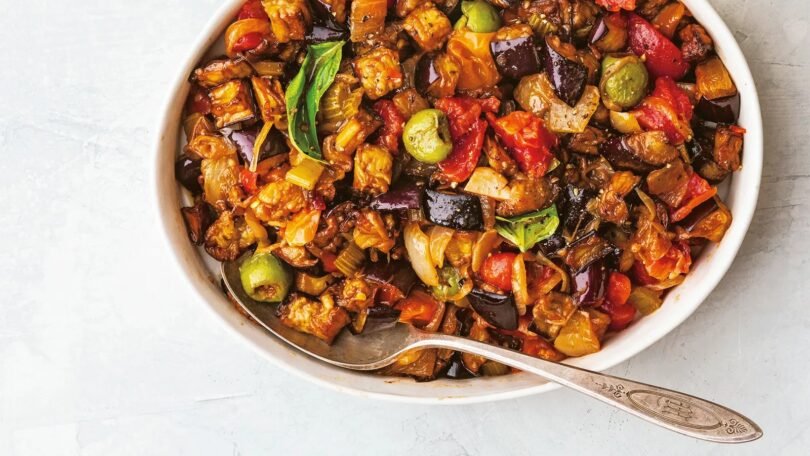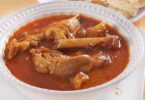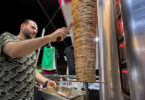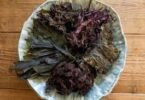Joe Baur
Sicily has long gripped the imagination of writers and travellers, setting the stage for epic moments in film and television. But many know Sicily best through its cuisine, shaped over more than 2,000 years of conquest by everyone from the Phoenicians, Greeks and Romans, to the Normans, Arabs and Spaniards. Left behind is a legacy of a flavourful, regional cuisine based primarily on grains, vegetables, legumes and fish brought to the modern world by Sicilian immigrants.
One of the more historically interesting dishes of Sicily is caponata, which is somewhere between a cooked aubergine salad and a stew that vaguely resembles ratatouille. As the aubergine simmers with tomatoes, celery, olives, capers, herbs and vinegar, it all turns into a savoury, briny mix – one that tastes even better the next day.
[jump to recipe]Anchored in Sicily’s historical Jewish community prior to its expulsion in 1492, the simple, sweet and sour vegetarian “stew” is arguably one of the oldest and emblematic dishes of the island.
Benedetta Jasmine Guetta is a Milan-born food writer, photographer, stylist and cookbook author. Last year, she published Cooking alla Giudia: A Celebration of the Jewish Food of Italy. The book is the result of more than a decade’s worth of research into Italian-Jewish cuisine. She’s also the owner of Café Lovi in Santa Monica, California, specializing in Jewish-inspired fare. The dish on the menu perhaps most deeply rooted in Guetta’s own heritage is the caponata.
Guetta said it’s not clear precisely how aubergine, which features in the dish, became so closely associated with Jewish people. The hypothesis is that Jewish merchants traded with Arab countries and got exposed to different ingredients, like cardoons, fennel, aubergine and spices that were not well known locally at the time. Another hint, Guetta explained, is that recipes with these ingredients would be described as “alla giudia” or “Jewish style”.
Regardless of how it came to be, now dishes like aubergine parmigiana, carciofi alla romana (Roman-style artichokes), and of course, caponata, are decidedly Italian. But Guetta said that few Italians outside of the Jewish community (of which she estimates there are about 35,000 left in the country) know about this history.
Where does caponata come from? There are a number of theories ranging from potential folklore to educated guesses. Like many centuries-old dishes, it’s impossible to attach an exact date to its creation. Enrica Bruno, a guide with Sicilian Food Tours in Palermo, said that “capone” in the Sicilian dialect is a mahi mahi fish, which was originally an ingredient in caponata. Wives of fishermen would prepare the dish for their husbands, unsure of when they’d return from sea. The vinegar would help keep the dish until the fishermen returned.
But, Bruno explained, fish was expensive. So cheap aubergine eventually replaced the fish.
Guetta is sceptical of this theory and is generally hesitant to verify most of the stories surrounding the medieval history of caponata, suggesting such tales are more likely folklore. But she shared another theory referred to by Italian cookbook author and James Beard award winner, Clifford A Wright, that the etymology stems from the Catalan word “caponado”, referring to a similar kind of dish.
“This Catalan word, which literally means ‘something tied together like vines’, can also refer to an enclosure where animals are fattened for slaughter,” explained Wright on his blog. “But the root word capón figures in the expression capón de galera, which is a gazpacho or a caponata-like dish.”
In his legendary tome, The Encyclopedia of Jewish Food, Gil Marks noted that the Jews of Sicily prepared a variety of cooked vegetable dishes for Shabbat. These dishes were served cold as a kind of salad during Shabbat lunch since cooking is forbidden during Shabbat. To this, Guetta said, “it makes sense,” but she’s still hesitant to agree to any origin story beyond what is well documented.
“All hypotheses are valid,” she said. “But unless they are really, truly documented, they should be taken with a pinch of salt.”
Guetta didn’t grow up with caponata among her Milano family. In fact, she only learned to make the dish some 15 years ago during a cooking class in Sicily with Fabrizia Lanza, the daughter of Anna Tasca Lanza, who launched the eponymous cooking school and centre of Sicilian culinary knowledge in 1989. Guetta immediately incorporated the dish into her Shabbat lunches, like the Sicilian Jews of yore are believed to have done, and it was added to her café menu when she opened it a year-and-a-half ago. For her, it’s a nod not only to her own story, but to an overlooked aspect of culinary history.
“There is a great and relevant contribution that Jews brought to Italy,” she said. “It just is not obvious to anybody, not to Italians, and let alone abroad.”
Many recipes for caponata call for cooking the vegetables separately, but Guetta said, “Life’s too short, my friend.” She chucks all of the vegetables together into the frying pan, only saving the basil for last. If you don’t feel like frying in peanut or sunflower oil, as is traditional, she said you can bake the aubergine.
No matter what, Guetta recommends keeping the dish seasonal and using the narrower Japanese aubergine for a less spongy or meaty texture. After cooking the caponata, she lets it rest to allow the flavours to come together. That could mean eating it later in the day, or even giving the dish overnight to marinate.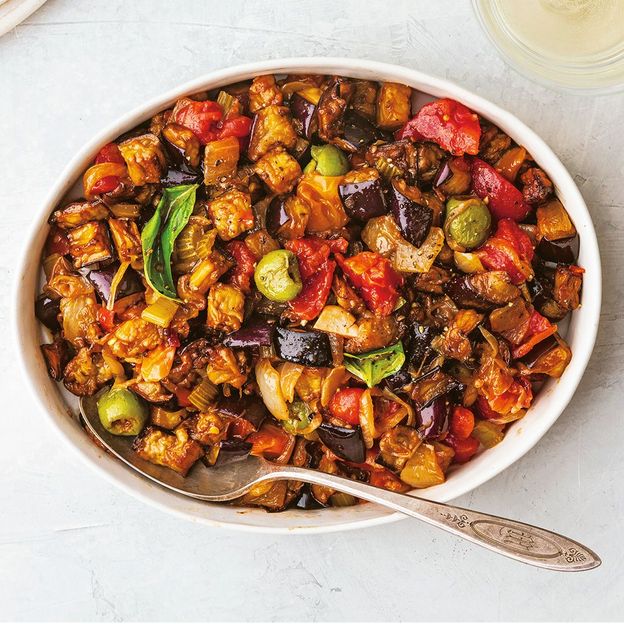
Caponata alla giudia: aubergine and vegetable stew (Credit: Cooking Alla Giudia)
Caponata alla giudia (aubergine and vegetable stew) recipe
By Benedetta Jasmine Guetta
Method
Step 1
Cut the aubergines into ¾-inch (2 cm) cubes. Transfer to a colander, salt generously, weight them down with a plate, and let drain for 30 minutes in the kitchen sink.
Step 2
Cut the half onion into very thin slices. Cut the whole onion into chunks roughly the same size as the aubergine cubes. Cut the celery into chunks and cut the cherry tomatoes in half.
Step 3
Pour the olive oil into a large non-stick skillet set over medium heat, add the sliced onion and garlic, and cook for about 3 minutes, until the garlic is slightly browned. Add the celery, tomatoes (both cherry and chopped), olives, capers and the chopped onion to the pan and cook for 10 minutes, until the vegetables begin to soften. Add the vinegar and sugar and cook for another 10 minutes. Remove from the heat.
Step 4
Remove the plate covering the aubergines and squeeze the aubergines in the colander to remove any remaining liquid.
Step 5
Pour 3cm (1 inch) of sunflower or peanut oil into a large saucepan and warm over medium heat until a deep-fry thermometer reads 180°C (350°F). You can test the oil by dropping a small piece of food, such as a slice of apple, into it: if it sizzles nicely but doesn’t bubble up too wildly, the oil is ready. (An apple is said to help minimize the smell of the frying oil, so I generally go for that, but any bit of food will do for testing the heat.)
Step 6
Add only as many aubergine cubes to the pan as will fit in a single layer without crowding and fry until golden, turning often. Remove the aubergine with a slotted spoon and spread out on a paper towel–lined plate to drain. Cook the remaining aubergine cubes in the same manner, adding more oil if needed.
Step 7
Once the fried aubergine has drained, add it to the skillet of vegetables. Season with ½ tsp salt and pepper to taste, adding a bit of water if the vegetables look dry, and cook the caponata over medium heat, stirring frequently, for 5 minutes.
Step 8
Stir in the basil leaves, remove from the heat, and let the caponata cool to room temperature before serving.
Courtesy: bbc

